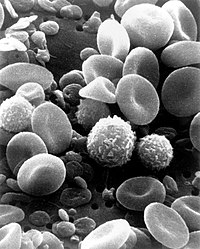
Photo from wikipedia
Previously, we reported that polymorphonuclear neutrophils (PMNs) are constantly existent in the bovine oviduct fluid during the pre-ovulatory stage under physiological conditions. Moreover, incubation of PMNs with bovine oviduct epithelial… Click to show full abstract
Previously, we reported that polymorphonuclear neutrophils (PMNs) are constantly existent in the bovine oviduct fluid during the pre-ovulatory stage under physiological conditions. Moreover, incubation of PMNs with bovine oviduct epithelial cells-conditioned medium (BOEC-CM) resulted in suppression of their phagocytic activity for sperm. During pathophysiological conditions, cows may be inseminated by infected semen which exposes oviductal PMNs to allogenic sperm simultaneously with pathogens. This study aimed to visually investigate the role of oviduct epithelium in regulating the phagocytic behavior of PMNs toward sperm as a physiological stimulus, with Escherichia coli (E. coli) as a pathological stimulus. In our experiment, PMNs were incubated for 2 h in BOEC-CM. Phagocytosis was then assayed by co-incubation of these PMNs either with sperm, E. coli, or latex beads. BOEC-CM significantly suppressed the direct phagocytosis of PMNs for sperm, but did not affect their phagocytic activity for E. coli or latex beads. Additionally, an investigation with scanning electron microscopy revealed that BOEC-CM suppressed the formation of DNA-based neutrophil extracellular traps (NETs) for sperm entanglement. BOEC-CM did not alter NETs formation towards E. coli. A quantification of NETs formation using an immunofluorescence microscopy showed that the areas of NETs formation for E. coli were significantly larger than those formed for sperm. Our data clearly show that the bovine oviduct, through secretions, protects sperm from phagocytosis by PMNs and eliminates bacterial dissemination through maintaining the phagocytic activity of PMNs towards bacteria.
Journal Title: Histology and histopathology
Year Published: 2019
Link to full text (if available)
Share on Social Media: Sign Up to like & get
recommendations!